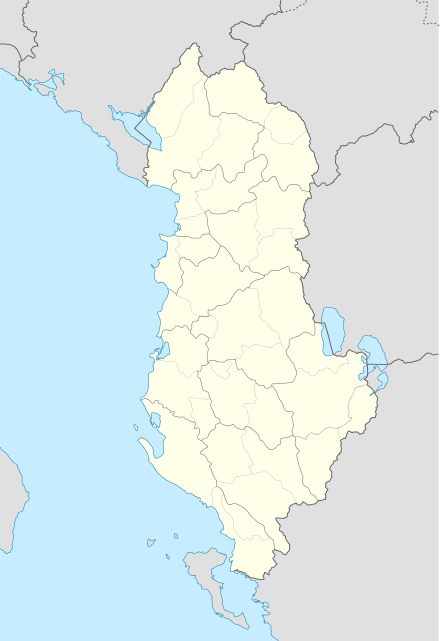List of World Heritage sites in Albania
The United Nations Educational, Scientific and Cultural Organization (UNESCO) World Heritage Sites are places of importance to cultural or natural heritage as described in the UNESCO World Heritage Convention, established in 1972.[1] Albania ratified the Convention Concerning the Protection of the World Cultural and Natural Heritage on 10 July 1989, making its historical sites eligible for inclusion on the list.[2]
As of 2018, there are three sites in Albania inscribed on the list and further five sites on the tentative list.[3] The first site in Albania to be added to the list was the ancient city of Butrint which was inscribed at the 16th UNESCO session in 1992.[4] The historic centre of Gjirokastër was inscribed in 2005 as Museum-City of Gjirokastra.[5] In 2008, the historic centre of Berat was added to the site, to form the Historic Centres of Berat and Gjirokastër.[6][7] In 2017, the Gashi River and Rrajcë regions were listed as part of the Ancient and Primeval Beech Forests of the Carpathians and Other Regions of Europe that is shared with eleven other countries.[8]
World Heritage Sites
UNESCO lists sites under ten criteria; each entry must meet at least one of the criteria. Criteria i through vi are cultural, whereas vii through x are natural.[9]
| Site | Image | Location (county) | Year listed | UNESCO data | Description |
|---|---|---|---|---|---|
| Butrint | 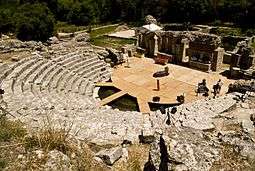 |
Vlorë | 1992 | 570; iii (cultural) | Butrint is known for its archaeological and natural heritage. Numerous monuments, some dating back to the antiquity, are still extant, such as the city walls, a late-antique baptistery, great basilica, theatre, and Venetian castles. The site is situated within a natural woodland with a complex ecosystem that depends on the nearby freshwater of Lake Butrint and Vivari Channel.[4] |
| Historic Centres of Berat and Gjirokastër |  |
Berat, Gjirokastër | 2005 | 569; iii, iv (cultural) | Berat and Gjirokastër are inscribed as rare examples of an architectural character of the Ottoman period. Berat bears witness to the coexistence of various religious and cultural communities down the centuries. It features a castle, most of which was built in the 13th century, although its origins date back to the 4th century BC. The citadel area hosts many Byzantine churches, mainly from the 13th century, as well as several mosques built in the 15th century. Gjirokastër features a series of outstanding two-story houses which were developed in the 17th century. The town also retains a bazaar, an 18th-century mosque, and two churches of the same period.[6] |
| Primeval Beech Forests of the Carpathians and Other Regions of Europe* | 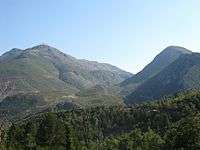 |
Kukës, Elbasan | 2017 | 1133; ix (natural) | This transboundary site (shared with Austria, Belgium, Bulgaria, Croatia, Germany, Italy, Poland, Romania, Slovakia, Slovenia, Spain, and Ukraine) encompasses the Gashi River in Tropojë, northeastern Albania, and the ancient beech forests of Rrajcë in Perrenjas, in central Albania. They demonstrate the postglacial expansion process of such forests and exhibit the most complete and comprehensive ecological patterns and processes of pure and mixed stands of European beech across a variety of environmental conditions.[8] |
Tentative list
In addition to the sites inscribed on the World Heritage list, member states can maintain a list of tentative sites that they may consider for nomination. Nominations for the World Heritage list are only accepted if the site was previously listed on the tentative list.[10] As of 2018, Albania records five sites on its tentative list.[11]
| Site | Image | Location (county) | Year listed | UNESCO criteria | Description |
|---|---|---|---|---|---|
| Amphitheatre of Durrës | 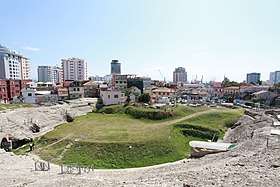 |
Durrës | 1996 | v (cultural) |
The Roman amphitheatre of Durrës was the largest in the Balkans. The amphitheatre has an elliptical shape with the longest axis of 136 metres (446 ft) and it was 20 metres (66 ft) high. It had a capacity of up to 20.000 spectators. After the 4th century AD, the amphiteatre ceased to serve its purpose and was gradually abandoned. Systematic excavations on the site started in 1966.[12] |
| Royal Tombs of Selca e Poshtme |  |
Korçë | 1996 | iii (cultural) |
The Illyrian tombs are located near the town of Pogradec near the village of Selcë e Poshtme. Most tombs were created in the 3rd century BC and were carved into the rock. Initially built for Illyrian kings, some of the tombs were later reused.[13] |
| Natural and Cultural Heritage of the Ohrid Region (Albania) | 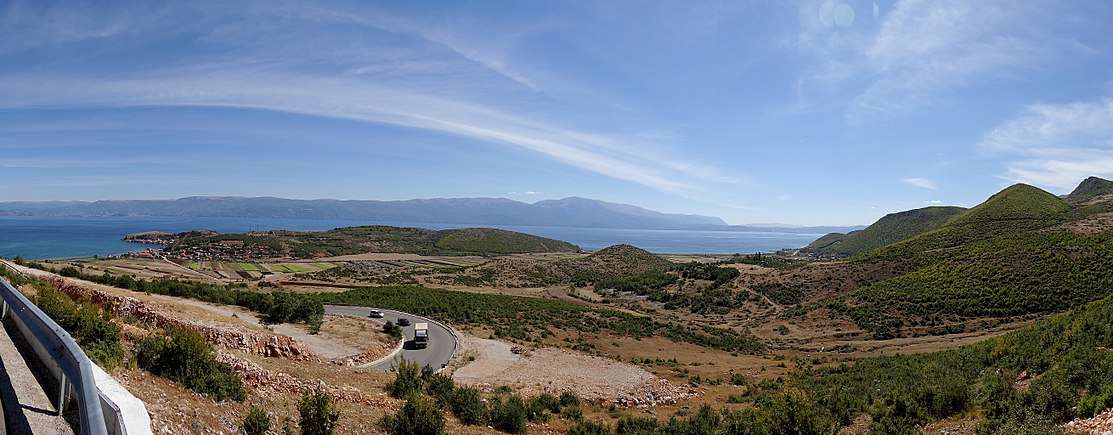 |
Korçë | 2011 | iii, iv, vii, ix (mixed) |
The area around the town of Pogradec shores of Lake Ohrid was inhabited by the Illyrians in the 5th century BC, followed by the Romans and the Slavs. Traces of the Roman road Via Egnatia are evidence of an important passage route in the region. The ruins of the paleochristian church of Lin together with its floor mosaics reveal the presence of Christianity. The historical centre of Pogradec represents an example of 19th-20th century Albanian vernacular architecture.[14] |
| The Ancient City of Apollonia | Fier | 2014 | ii, iii, x (mixed) |
The city of Apollonia was likely founded in the 6th century BC by Greek colonists from Corfu and Corinth. The city flourished in the 4th century BC and was an important trade and economic center, one of the most eminent cities of the Adriatic basin. During the Roman times, it was one of the gateways to Via Egnatia. Throughout its existence, the culture and the general development of the city maintained a clear Greek character while keeping close relationship with the Illyrian hinterland. The city was abandoned during the medieval period.[15] | |
| The Castle of Bashtova | 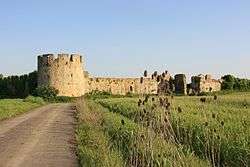 |
Tirana | 2017 | iv (cultural) |
Accordig to the Ottoman sources, the castle was built by the Venetians to protect important routes. The Ottomans conquered it in 1478 and made further structural modifications. The castle had a rectangular plan, 60 metres (200 ft) x 90 metres (300 ft) and had three entrances. Two circular and one rectangular tower are still preserved today.[16] |
See also
References
- ↑ "The World Heritage Convention". UNESCO World Heritage Centre. Retrieved September 17, 2010.
- ↑ "Albania". UNESCO World Heritage Centre. Retrieved 25 July 2017.
- ↑ "UNESCO World Heritage Centre - Tentative Lists". UNESCO World Heritage Centre. Retrieved 8 September 2018.
- 1 2 "Butrint". UNESCO World Heritage Centre. Retrieved 8 September 2018.
- ↑ "Museum-City of Gjirokastra" (PDF). Retrieved 8 September 2018.
- 1 2 "Historic Centres of Berat and Gjirokastra". UNESCO World Heritage Centre. Retrieved 8 September 2018.
- ↑ "UNESCO World Heritage Centre - Three new sites inscribed on UNESCO's World Heritage List". UNESCO World Heritage Centre. Retrieved 8 September 2018.
- 1 2 "Ancient and Primeval Beech Forests of the Carpathians and Other Regions of Europe". whc.unesco.org. UNESCO World Heritage Centre. Retrieved 8 September 2018.
- ↑ "UNESCO World Heritage Centre – The Criteria for Selection". UNESCO World Heritage Centre. Retrieved 17 August 2018.
- ↑ "UNESCO World Heritage Centre – Tentative Lists". UNESCO World Heritage Centre. Retrieved 25 July 2017.
- ↑ "UNESCO World Heritage Centre – Tentative Lists: Albania". UNESCO World Heritage Centre. Retrieved 6 January 2018.
- ↑ "L'amphithéâtre de Durres" (in French). UNESCO World Heritage Centre. Retrieved 8 September 2018.
- ↑ "Les tombes de la Basse Selca" (in French). UNESCO World Heritage Centre. Retrieved 8 September 2018.
- ↑ "Natural and Cultural Heritage of the Ohrid Region". UNESCO World Heritage Centre. Retrieved 8 September 2018.
- ↑ "The Ancient City of Apollonia". UNESCO World Heritage Centre. Retrieved 8 September 2018.
- ↑ "The Castle of Bashtova". UNESCO World Heritage Centre. Retrieved 8 September 2018.
